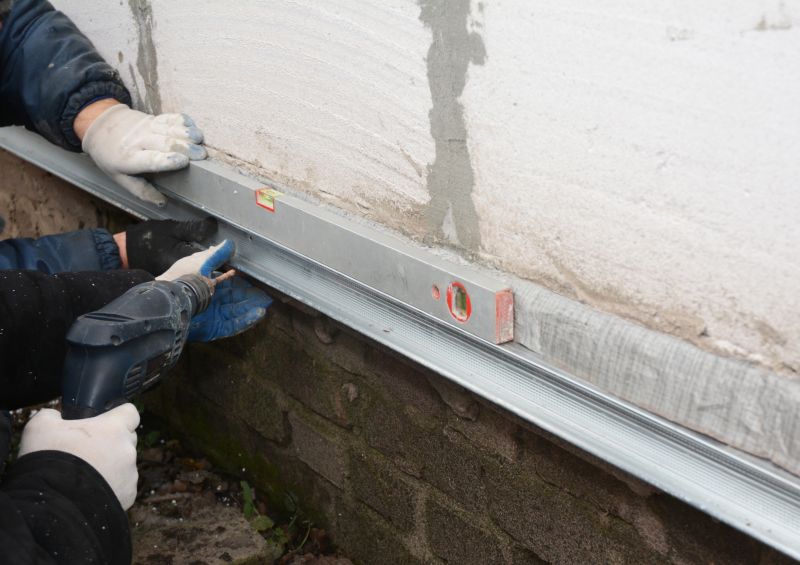Leading Selection of Foundation Repair Products for Home Improvement
Browse top products that help you address foundation issues and improve your home's structural safety.
 Foundation repairs are a critical aspect of maintaining the structural integrity of a building. When signs of foundation issues appear, such as cracks in walls, uneven floors, or sticking doors and windows, it is essential to explore appropriate repair products. These solutions vary widely in design and application, ranging from hydraulic jacks to underpinning systems. Selecting the right products can help stabilize and reinforce the foundation, potentially preventing further damage and ensuring safety.
Foundation repairs are a critical aspect of maintaining the structural integrity of a building. When signs of foundation issues appear, such as cracks in walls, uneven floors, or sticking doors and windows, it is essential to explore appropriate repair products. These solutions vary widely in design and application, ranging from hydraulic jacks to underpinning systems. Selecting the right products can help stabilize and reinforce the foundation, potentially preventing further damage and ensuring safety.
Top Overall Option
Adjustable Support Jack System
An adjustable support jack system offers a versatile and customizable approach to foundation stabilization. It allows for precise lifting and leveling of uneven areas, making it suitable for various foundation types and damage severities. Its ease of installation and adaptability make it a popular choice among professionals and experienced DIYers alike.
Types of Products For Foundation Repairs
Piering Systems
Used to lift and stabilize sinking foundations by installing piers beneath the structure.
Helical Piers
Deep support piers suitable for challenging soil conditions, providing long-term stabilization.
Slab Jacking Materials
Injection compounds used to lift and level concrete slabs affected by settlement.
Crack Injection Kits
Seal and reinforce small to medium cracks to prevent water intrusion and further damage.
Underpinning Systems
Enhance the support of existing foundations through various underpinning techniques.
Soil Stabilization Products
Chemical compounds that improve soil strength and reduce settlement issues.
Drainage Solutions
Systems designed to divert water away from foundations to prevent moisture-related problems.
Concrete Patching Materials
Repair cracked or damaged concrete surfaces on foundations and slabs.
Lifting Posts and Jacks
Tools used to manually lift and level foundation sections during repair work.
Waterproofing Membranes
Protect foundation walls from water infiltration and moisture damage.
Vapor Barriers
Install beneath slabs to control moisture migration and improve soil conditions.
Structural Reinforcement Beams
Add support to weakened foundation sections to prevent further movement.
Popular Choices
A common method for stabilizing sinking foundations by hydraulically installing piers.
Flexible strips used to reinforce cracked walls and prevent further cracking.
Versatile foam used to fill voids and lift slabs in a minimally invasive manner.
Heavy-duty piers designed for deep foundation support and stabilization.
Chemical grouts used to improve soil properties beneath foundations.
Sealants designed for quick and effective crack repairs on foundation surfaces.
Manual jacks that allow for precise leveling of foundation elements.
Effective drainage solutions to manage water flow around foundations.
High-strength epoxy used to bond and reinforce cracked concrete surfaces.
Complete setups for managing water around the property to prevent future issues.
Methods to improve soil stability through controlled grouting techniques.
Additional beams installed to support and strengthen compromised foundation sections.
Different foundation repair products are designed to address specific types of issues, whether they involve settling, shifting, or cracking. For example, piering systems are often used to lift and stabilize a sinking foundation, while helical piers provide deep support in challenging soil conditions. Crack injection kits can seal and reinforce minor cracks, preventing water infiltration and further deterioration. Understanding the unique needs of a property is vital when choosing the correct repair products.
In addition to structural solutions, there are also surface-level products such as soil stabilization compounds and drainage systems that can mitigate future foundation problems. Proper installation and professional assessment are recommended to ensure the effectiveness of these products. Homeowners and contractors alike should consider the type of foundation, extent of damage, and soil conditions when selecting repair solutions.
Ultimately, investing in quality foundation repair products can contribute to the longevity and safety of a property. While DIY options exist, consulting with foundation specialists often provides tailored solutions that address specific issues comprehensively. Regular inspections and timely repairs can help maintain the stability of a building, especially in areas prone to soil movement or moisture fluctuations.
Key Buying Considerations
- Assess the extent and type of foundation damage to determine suitable repair products.
- Consider the soil conditions and how they influence product selection and installation methods.
- Evaluate the compatibility of repair products with existing foundation materials.
- Determine whether professional installation is recommended or if DIY options are feasible.
- Review the load-bearing capacity and durability of the products for long-term stability.
- Check for products that offer flexibility for future adjustments or repairs.
- Ensure that the chosen solutions are compliant with local building codes and regulations.
- Consider the ease of access and installation in tight or hard-to-reach areas.
- Look for products with clear instructions and support resources for proper application.
- Factor in the potential impact on property value and structural safety.
- Compare warranties or guarantees offered by product manufacturers or suppliers.
- Research the reputation and reviews of the products and their manufacturers.
- Estimate the total cost, including materials and professional services if needed.
- Identify products that are suitable for the specific foundation type (slab, crawl space, basement).
- Consider environmental factors that might influence the longevity of repair solutions.
